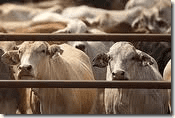Data due on Friday expected to show the US cattle herd shrinking to its lowest on record could represent a marker on the road to a far more profitable ranching sector.
The US Department of Agriculture is due later, in a twice-yearly report, to show the domestic cattle herd falling by 1.4% from July 1, dropping below 100m head for the first time since the series began in 1973.
The decline is seen in part down to the sector’s greater productivity since the spread of feedlots, which has allowed producers to shorten fattening periods while increasing animal weights.
US producers are expected to produce some 26m pounds of beef, nearly one-quarter more than in 1973, despite a herd which has shrunk by one-quarter over the same period.
But it is also "a reflection of the fact that grain farming is more profitable than cattle ranching", Don Roose, president of broker US Commodities said.
"It has been more profitable for farmers to tear up pastures and replace them with crops."
Supply squeeze ahead?
However, the extent of the decline in the cattle herd may swing the pendulum of profitability back towards ranchers, once high beef prices persuade the industry to go back into expansion mode, a report by Paragon Economics and Steiner Consulting said.
Expectations for USDA cattle herd data, as change in year to July 1
All cattle and calves: -1.4%
Cows and heifers that have calved: -1.3%
(Includes beef cows: -1.9%
And dairy cows: -0.1%)
Annual calf crop: -1.5%
Source: Dow Jones survey
The increased beef production has come against a background of population growth to 7bn people worldwide, from 4bn people in the early 1970s.
"Increasing global incomes, lower trade barriers and more fluid markets have led to ever-rising beef demand globally," the briefing said.
"All of this will put more pressure on US beef prices long term, and cattle prices will rise to points that once again make it profitable to invest in this business."
Indeed, if cattle prices appear high now – with futures in both feeder animals, ready for placement in feedlots, and live animals, ready for slaughter, within 10% or so of record highs – "they will be even higher when producers finally decide to hold back heifers for herd rebuilding".
Friday’s report is expected to show the calf crop falling 1.5%, implying some 2m fewer calves produced than five years ago.
‘No feed in Texas’
One factor which has held back cattle production this year is the drought in the US South which has threatened pasture on an area home to roughly one-third of the US herd.
Expectations for USDA cattle on feed data, as year-on-year change
Total cattle on feed, July 1: +2.7%
Placed on feedlots in June: -6.6%
Marketed in June: +2.8%
Source: Thomson Reuters survey
Indeed, the dryness has been seen as a major impetus behind a jump in placements, even of smaller than-usual cattle, on feedlots, until a sharp slowdown in June.
Analysts are divided over whether a separate USDA report on Friday, a monthly census on feedlots, will show buy-ins of feeder cattle remaining weak last month, or whether the dryness revived placements.
At Country Futures, Jerry Stowell, while forecasting a 10% slide in placements for June, said the number "could be up 20% for July" because of the shortage of fodder.
"There is no feed in Texas – no hay, no nothing," Mr Stowell said.
http://www.agrimoney.com/news/record-low-cattle-herd-could-herald-profits-surge–3392.html


Deprecated: strpos(): Passing null to parameter #1 ($haystack) of type string is deprecated in /home/agriviek8Qv/agriviet.net/public_html/wp-includes/comment-template.php on line 2522